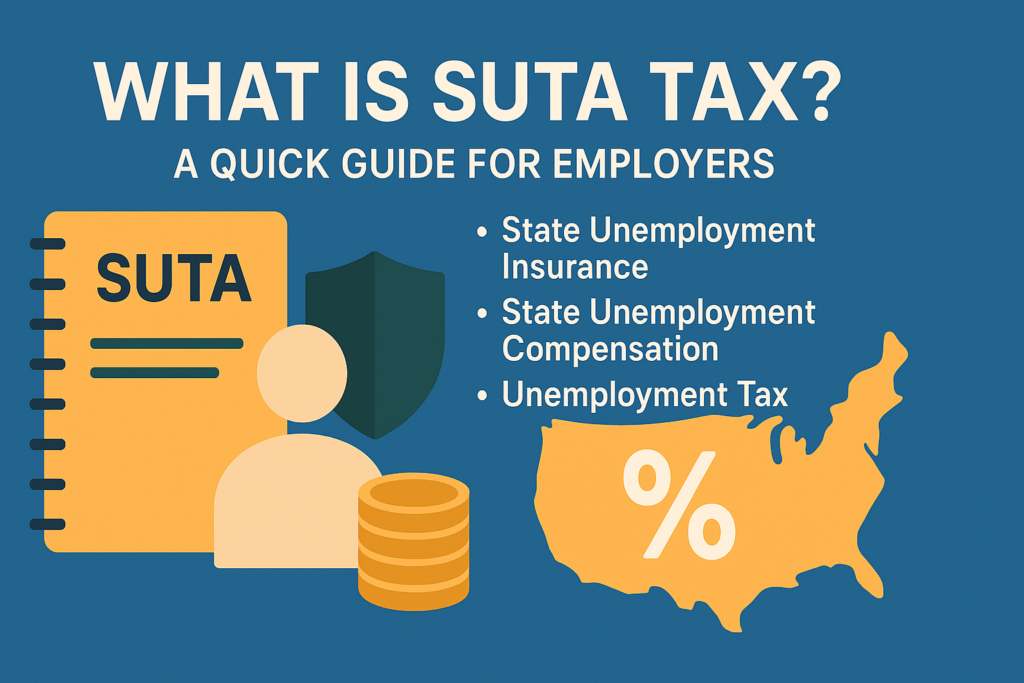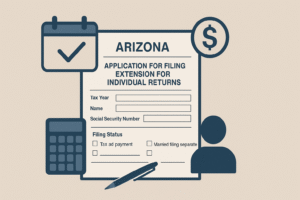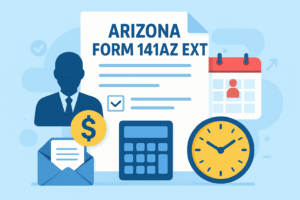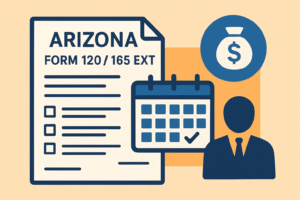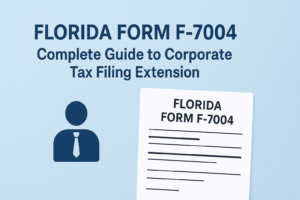The State Unemployment Tax Act (SUTA) is a crucial payroll responsibility that helps fund unemployment benefits for workers who have lost their jobs through no fault of their own. While SUTA is mandatory for most employers, the rules, rates, and payment schedules vary by state. This comprehensive guide will answer all your key questions about SUTA—from how it works to how it’s paid, reported, and optimized.
What Does SUTA Pay For?
SUTA funds each state’s unemployment insurance program. These programs provide temporary financial support to eligible workers, help them find new employment, and support workforce development initiatives.
Does SUTA Have Any Other Names?
Yes, SUTA may also be called:
- State Unemployment Insurance (SUI)
- State Unemployment Compensation
- Unemployment Tax
Terminology varies by state, but they all refer to the same type of payroll tax.
What’s the Difference Between SUTA and FUTA?
| Feature | SUTA | FUTA |
| Level | State | Federal |
| Collected By | State Workforce Agencies | IRS |
| What It Funds | State unemployment benefits | Admin costs & loans to states |
| Who Pays | Employers (some states: both) | Employers only |
SUTA and FUTA work together to fund unemployment benefits, but are administered separately.
Who Pays SUTA?
Typically, only employers pay SUTA. However, a few states—including Alaska, New Jersey, and Pennsylvania—require employees to contribute as well.
Who Is Exempt From SUTA?
SUTA exemptions can apply to:
- Certain nonprofit and religious organizations
- Government agencies
- Sole proprietors with no employees
Exemption rules vary by state, so it’s important to confirm with the state labor department.
How Do Employers Register for SUTA?
Registration is generally done through the state’s Department of Labor or Workforce Agency website. Employers will need to provide:
- Legal business name and EIN
- Type of business entity
- Number of employees and first payroll date
Once registered, employers receive a state unemployment insurance (UI) account number.
What Are SUTA Rates?
SUTA tax rates vary by state and employer. New employers usually pay a standard rate, while experienced employers receive a customized rate based on their unemployment claims history (experience rating).
SUTA Wage Base and Tax Rate by State (2025)
| State / DC | Wage Base | New‑Employer Rate | Rate Range (Experienced) |
| Alabama | $8,000 | 0.20 % | 0.20 – 6.80 % (paycom.com, ballotpedia.org) |
| Alaska | $51,700 | 1.00 % | 1.00 – 5.40 % |
| Arizona | $8,000 | 0.04 % | 0.04 – 9.72 % |
| Arkansas | $7,000 | 0.20 % | 0.20 – 10.1 % |
| California | $7,000 | 1.50 % | 1.50 – 6.20 % |
| Colorado | $27,200 | 0.64 % | 0.64 – 12.34 % |
| Connecticut | $26,100 | 0.10 % | 0.10 – 10.0 % |
| Delaware | $12,500 | 0.20 % | 0.20 – 5.40 % |
| District of Columbia | $9,000 | 1.00 % | 1.00 – 7.40 % |
| Florida | $7,000 | 0.10 % | 0.10 – 5.40 % |
| Georgia | $9,500 | 0.06 % | 0.06 – 8.10 % |
| Hawaii | $62,000 | 2.40 % | 2.40 – 5.60 % |
| Idaho | $55,300 | 0.23 % | 0.23 – 5.40 % |
| Illinois | $13,916 | 0.75 % | 0.75 – 7.85 % |
| Indiana | $9,500 | 0.50 % | 0.50 – 11.20 % |
| Iowa | $39,500 | 0.00 % | 0.00 – 7.00 % |
| Kansas | $14,000 | 0.00 % | 0.00 – 6.65 % |
| Kentucky | $11,700 | 0.30 % | 0.30 – 9.00 % |
| Louisiana | $7,700 | 0.09 % | 0.09 – 6.20 % |
| Maine | $12,000 | 0.30 % | 0.30 – 6.27 % |
| Maryland | $8,500 | 0.30 % | 0.30 – 7.50 % |
| Massachusetts | $15,000 | 0.83 % | 0.83 – 12.65 % |
| Michigan | $9,000 | 0.06 % | 0.06 – 10.30 % |
| Minnesota | $43,000 | 0.40 % | 0.40 – 8.90 % |
| Mississippi | $14,000 | 0.00 % | 0.00 – 5.40 % |
| Missouri | $9,500 | 0.00 % | 0.00 – 6.00 % |
| Montana | $45,100 | 0.00 % | 0.00 – 6.12 % |
| Nebraska | $9,000 | 1.25 % | 0.00 – 5.40 % |
| Nevada | $41,800 | 0.30 % | 0.30 – 5.40 % |
| New Hampshire | $14,000 | 1.00 % | 1.00 – 7.00 % |
| New Jersey | $43,300 | 0.60 % | 0.60 – 6.40 % |
| New Mexico | $33,200 | 0.33 % | 0.33 – 5.40 % |
| New York | $12,800 | 0.00 % | 0.00 – 8.90 % |
| North Carolina | $32,600 | 0.06 % | 0.06 – 5.76 % |
| North Dakota | $45,100 | 0.08 % | 0.08 – 9.69 % |
| Ohio | $9,000 | 0.50 % | 0.50 – 10.20 % |
| Oklahoma | $28,200 | 0.30 % | 0.30 – 9.20 % |
| Oregon | $54,300 | 0.90 % | 0.90 – 5.40 % |
| Pennsylvania | $10,000 | 1.42 % | 1.42 – 10.37 % |
| Rhode Island | $29,800 | 1.10 % | 1.10 – 9.70 % |
| South Carolina | $14,000 | 0.06 % | 0.06 – 5.46 % |
| South Dakota | $15,000 | 0.00 % | 0.00 – 8.80 % |
| Tennessee | $7,000 | 0.01 % | 0.01 – 10.00 % |
| Texas | $9,000 | 0.25 % | 0.25 – 6.25 % |
| Utah | $48,900 | 0.20 % | 0.20 – 7.20 % |
| Vermont | $14,800 | 0.40 % | 0.40 – 5.40 % |
| Virginia | $8,000 | 0.10 % | 0.10 – 6.20 % |
| Washington | $72,800 | 0.27 % | 0.27 – 8.15 % |
| West Virginia | $9,500 | 1.50 % | 1.50 – 8.50 % |
| Wisconsin | $14,000 | 0.00 % / 3.05‑3.25 % | 0.00 – 12.00 % |
| Wyoming | $32,400 | 0.00 % | 0.00 – 8.50 % |
Who Determines SUTA Rates?
Each state’s workforce or labor department sets SUTA rates based on statutory formulas, trust fund solvency, and employer experience ratings.
How Are SUTA Rates Determined?
Factors include:
- History of unemployment claims
- Length of time in business
- Industry classification
- Size of payroll
New businesses usually pay a fixed rate until they accumulate enough data for experience rating.
How to Calculate SUTA Tax
Formula:
SUTA Tax = Taxable Wages x Assigned SUTA Rate
Example:
- Wage base: $9,000 (Texas)
- Rate: 2.7%
- SUTA Tax = $9,000 × 2.7% = $243 per employee annually
When Are SUTA Rates Determined?
SUTA rates are generally recalculated and assigned annually, usually at the beginning of the calendar year.
Can SUTA Rates Change?
Yes. SUTA rates may change yearly based on:
- Unemployment claim trends
- State trust fund levels
- Employer’s claims history
Where Can Employers Find Their SUTA Rate?
You can find your rate by:
- Checking your annual rate notice from the state
- Logging into your state unemployment portal
- Contacting your state’s labor agency directly
How Can Employers Reduce Their SUTA Liability?
Ways to lower SUTA costs include:
- Minimizing turnover
- Contesting invalid claims
- Filing timely reports
- Making voluntary contributions (where allowed)
How to Pay SUTA Tax
Paying SUTA tax involves these steps:
- Calculate: Multiply taxable wages by the SUTA rate.
- File: Submit quarterly wage reports via your state’s online portal.
- Pay: Make payments electronically (ACH or debit). Most states require e-payment.
Keep payment confirmations for your records.
How to Report SUTA Tax and When Is the Deadline?
Employers must report total wages, taxable wages, and contributions on a quarterly basis.
| Quarter | Reporting Period | Due Date |
| Q1 | January 1 – March 31 | April 30 |
| Q2 | April 1 – June 30 | July 31 |
| Q3 | July 1 – September 30 | October 31 |
| Q4 | October 1 – December 31 | January 31 |
Deadlines and required forms vary by state, so verify with your local agency.
What Happens If Employers Miss SUTA Payments?
Late or missed SUTA payments can lead to:
- Penalties and interest
- Loss of FUTA tax credits
- Increased audit risk
Timely compliance is critical to avoiding financial and legal consequences.
What If an Employer Has Employees in Multiple States?
Multi-state employers must:
- Register for SUTA in each applicable state
- Report and pay based on that state’s wage base and rate
- Track state-specific deadlines and rules
Using payroll software or a tax professional can streamline multi-state compliance.
Conclusion
Understanding and managing SUTA tax is an essential part of employer responsibilities. From registration to quarterly reporting and tax rate monitoring, proactive compliance can reduce your financial burden and help avoid penalties. Stay informed with your state’s latest rules and rates, and seek professional support if needed.

